Photographing Sunset Pass in Banff National Park, Canada |
Who says you can't have your cake and eat it too? With a little bit of planning, a photographer can escape the restrictive partnership of car-and-road to seek out the wonderful photographic opportunities waiting beyond the shoulders of mountains. Sunset Pass in world-famous Banff National Park is one such off-road experience open to the intrepid, backpacking photographer. I recently hiked to the little gem of a meadow at the start of the Pass and spent a couple of days with friends enjoying the lazy summer light in the high, alpine valley. With a little planning on how to 'pack light' with your camera gear, such delights are open to any moderately fit photographer.
Perhaps I should stress the 'fit' part of moderately fit. Make no mistake, hiking up a mountain with your tent, sleeping bag, clothes, food AND camera gear means a hefty backpack! While you don't have to be a triathlete to attempt photography-based backpacking, you do need some outdoor skills and a basic level of physical strength. On the other hand, if you are looking to escape the crowded highways crawling with tourists, a short backcountry jaunt may be just the ticket. It would be a shame if the only thing that holds you back is your level of fitness.
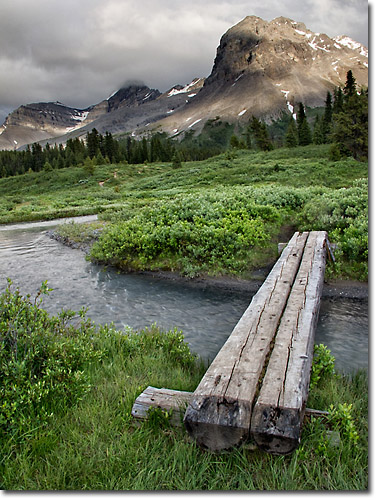
Sunset Pass is 8.2 km (5.1 mi) from the trailhead but there is great shooting all along the trail. Take time to check out the several lookouts to impressive Norman Creek gorge where Norman Creek thunders toward the highway you just left (and catch your breath for the ascent still to come!) Continue up the switchback trail observing the variety of mushrooms, wildflowers and forest undergrowth that abound the steep slopes. At about 2.9 km (1.8 mi) you will come to a junction to Sunset Lookout. You've come 420 m (1378 ft) in about an hour, so you may wish to head to the Lookout 1.6 km (1 mi) distant for views down the North Saskatchewan River Valley or, if you are intent on vanquishing the mountain, proceed on your ascent toward the Pass.
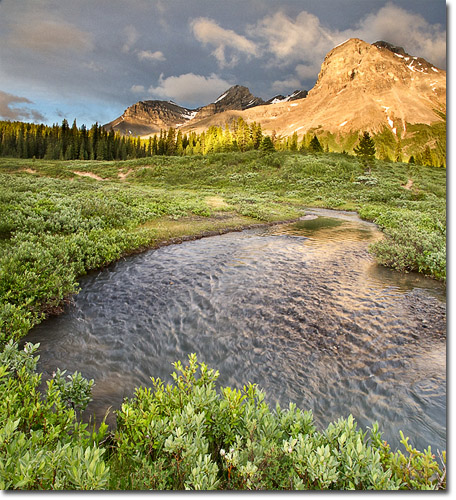
If you are planning on catching some mountain light, then stay at Norman Lake campground found 4.2 km (2.4 mi) into the hike at the start of the Pass. From here you are on the edge of a long, willow-filled meadow decorated with tinkling creeks, grassy marshes and windswept pine. Norman Lake is on one edge of the meadow and Norman Creek winds toward the campground. Wake up, roll out of your tent, and shoot sunrise on the peaks before breakfast! Or meander through the meadow in the golden glow of the evening and catch the pinks and peaches of sunset before snuggling into your down-filled sleeping bag at night. Sunset Pass is ideal for photographers because of the orientation of the Pass; the long meadow runs north-south and is fringed with peaks all around. In summer, catch sunrise on Mount Coleman and sunset on Mount Wilson. Mount Erasmus lurks behind Mount Amery to the south end of the meadow. Look for wildflowers such as Indian paintbrush, elephant's head, shooting stars and mountain avens in the grassy areas near streams or, if you arrive in early to mid-July, seek out the carpets of yellow glacier lilies revealed by shrinking snow drifts.
Sunset Pass trailhead is found on the Icefields Parkway, the busy, winding mountain road that connects the Banff and Jasper National Parks. When you finally leave that hectic highway behind, you have the chance to see more wildlife. Listen for the cries of goshawks, the warning whistles of Columbian ground squirrels and even the hoot of an owl. At night, the strange, whirring sound of the night hawk may tinge your dreams with unease, but the bird is harmless despite its early reputation as a vampirish creature. You may see deer or elk—but remember you are in bear country. High alpine meadows are prime habitat for grizzly bears so make sure you know how to conduct yourself in bear country. Make lots of noise when hiking and stay vigilante when out photographing. The campground is equipped with bear-proof storage so make sure you hang all your food, soaps and toiletries on the poles provided. Also, there's a reason why the eating areas are separated from the sleeping areas: never eat in or near your tent in bear country! Following a few simple rules will ensure critters stay wild and you stay alive. The Norman Lake campground has an outhouse, but bring your own t.p.!
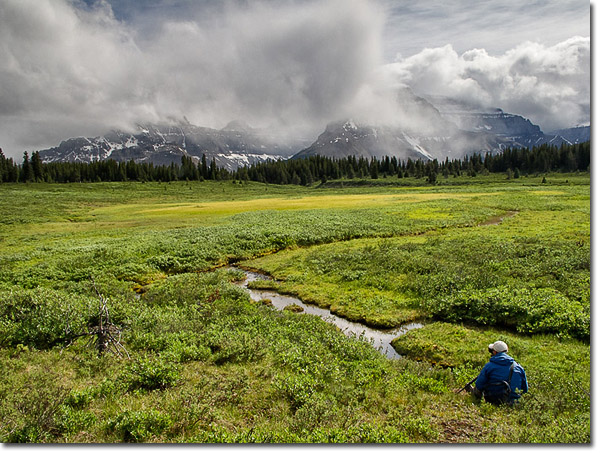
Now for the gear…I have learned the hard way that, as much as you want to, you just can't take every bit of camera gear with you. Obtaining an injury from a heavy pack will ruin your hike and possibly your summer of shooting, so be prepared to trim your gear down to the absolutely minimal. The weight you can carry on your back for a hike will depend in part on your fitness level but a general rule of thumb is to aim for no more than 25% - 30% of your ideal body weight. Packing light is an art form, but do take advantage of all the technological breakthroughs in light-weight gear. Invest in items such as small, durable tents, compact stoves and nested cook sets and choose down sleeping bags over synthetic fill.
Think light when it comes to your camera gear as well. Leave your pro-body dSLR and extra battery pack at home and opt for your small, backup dSLR (if you are lucky enough to have one) or even a point 'n shoot camera with some manual control. A single zoom lens will cover most bases. Bringing a backpacking tripod is a necessity if you plan to shoot sunrise or sunset but luckily there are models available that are built to be lightweight yet sturdy. For the Sunset Pass hike, I took along a Canon G11 which gave me some control over aperture, shutter speed and bracketing exposures while still being relatively lightweight. I also took along a lightweight Optex Travelite carbon fibre tripod. Although I did not have the full range of options in terms of lens choice, filters and tripod height, my camera gear weighed only 4 pounds in total so I could bring it without making my hike overly strenuous. Don't forget to bring extra cards and camera batteries and to factor those into the weight of your pack!
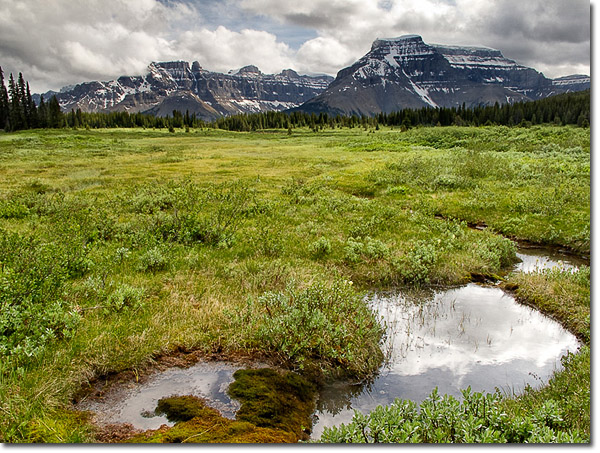
With a little bit of planning and financial investment, you can easily explore new photographic opportunities in the wilderness. If you find yourself in Banff National park, try a short backpack trip such as Sunset Pass to bring home exciting new images off the beaten track.
Resources:
REI's How to Load a Backpack
Backpacking Light
Backcountry Attitude
see also Ben Gadd's The Canadian Hiker's & Backpacker's Handbook and Kathy and Craig Copeland's excellent trail guide, Don't Waste Your Time in the Canadian Rockies.
Comments on NPN nature photography articles? Send them to the editor. NPN members may also log in and leave their comments below.
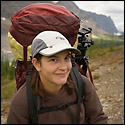 Samantha Chrysanthou was born in Lethbridge, Alberta. After moving for a period of time to northern Alberta, she returned in 2000 to southern Alberta to pursue a law degree in Calgary. After becoming a lawyer, Samantha began to realize her heart was more engaged in capturing the beauty of the landscape around her than debating the nuances of legal arguments in court. She has since left law to pursue writing and photography full-time. She particularly enjoys shooting the prairies, foothills and Rocky Mountains within an hour or so of her home in Cochrane, Alberta. Visit Samantha's website to view more of her work at www.chrysalizz.smugmug.com.
Samantha Chrysanthou was born in Lethbridge, Alberta. After moving for a period of time to northern Alberta, she returned in 2000 to southern Alberta to pursue a law degree in Calgary. After becoming a lawyer, Samantha began to realize her heart was more engaged in capturing the beauty of the landscape around her than debating the nuances of legal arguments in court. She has since left law to pursue writing and photography full-time. She particularly enjoys shooting the prairies, foothills and Rocky Mountains within an hour or so of her home in Cochrane, Alberta. Visit Samantha's website to view more of her work at www.chrysalizz.smugmug.com.